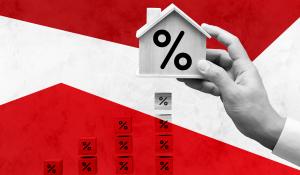
Profit margins on median-priced single-family and condo sales across the U.S. decreased to 54.6% in the third quarter, according to a new report from real estate data company ATTOM.
This is the first decline in home prices in almost three years, down from 57.6% in the second quarter, with median national home values dropping 3% quarterly to approximately $340,000, the report said.
Despite this drop, investment returns for home sellers is still up from 48.8% in the third quarter of 2021, and still at near-record levels for the century (20 points higher than two years ago). The median home price is also still at a near all-time high, more than double where it was 10 years ago, according to the report.
On the other hand, investment-return decline during this year’s summertime home-selling season marked the largest quarterly downturn since 2011, with the third-quarter reversal also marking the first since 2010 that seller returns went down from the second to third quarter.
This coincides with a decrease in gross profits during that time, with the typical single-family home and condo sale dropping 6% to $120,100, representing the largest quarterly decrease since early 2017.
The report attributes these declines to “growing headwinds that threaten to end or significantly cool down the nation’s decade-long housing market boom”, including a doubling in average mortgage rates, a slumping stock market, a 40-year high in consumer price inflation and double in foreclosure activity by lenders.
ATTOM says these factors are raising homeownership costs for buyers, which it says “cuts into resources available for down payments on purchases” and impacts overall household budgets. This has resulted in a growing supply of homes for sale, and in turn pushed home prices down (though not in every market).
Metro results for home sellers
While typically profit margins, or the percent change between median purchase and resale prices, decreased from the second quarter to the third quarter of 2022 in 68% of metropolitan statistical areas (127 of 186), returns were still up annually in 148 of these markets (78%)
The report states that the biggest quarterly decreases in typical profit margins came in the metro areas of:
Claramont-Lebanon, NH (down from 72.8% in the Q2 to 52.4% in Q3)San Francisco, CA (down from 85.1% in Q2 to 65.4% in Q3)Prescott, AZ (down from 86.3% in Q2 to 70.8% in Q3)Barnstable, MA (down from 74.5% to 59.6% in Q3)Trenton, NJ (down from 74.5% to 61% in Q3)
ATTOM also found that just 59 of 186 (32%) of markets that did see increased profit margins in the third quarter, with the largest quarterly increases including:
Macon, GA (up from 44.7% in Q2 to 82.4% in Q3)Rockford, IL (up from 29.9% in Q2 to 41.8% in Q3)Davenport, IA (up from 29.2% in Q2 to 40% in Q3)Akron, OH (up from 52.8% in Q2 to 60.3% in Q3)Hilo, HI (up from 103.3% in Q2 to 110.9% in Q3)
The report also found that metro areas with a population of at least one million saw the largest quarterly profit-margin declines in San Francisco, Seattle, San Jose, Raleigh and Birmingham. Larger markets experiencing profit increases include Milwaukee, Miami, Cincinnati, Nashville and Grand Rapids.
Cash sales and institutional investors
All-cash purchases continue to represent a large slice of single-family home and condo sales, accounting for 35.7% of all sales in the third quarter of 2022. This is slightly down from 36% last quarter, but is still above the 33.9% of sales in Q3 of 2021.
Markets with the largest share of all-cash purchases include Columbus, GA (76.8%), Augusta, GA (76.6%), Gainsville, GA (68.3%), Myrtle Beach, SC (67.3%) and Atlanta, GA (61.9%). Cash-sales represented the smallest share of all transactions in Lincoln, NE (14.9%), Valleja, CA (17.6%), San Jose, CA (18.8%), Kennewick, WA (19.4%) and Spokane, WA (20.2%).
These high levels of all-cash offers also coincides with a rise in institutional investment purchases, accounting for 6.7% of all single-family home purchases in the third quarter. While this is up from 6.4% last quarter, it is also down from 8.4% at this time last year.
FHA-financed purchases
Another interesting trend occurring in the third quarter is the increase in Federal Housing Administration (FHA) loans, which now comprise 7.9% of all home purchases in the third quarter (one in every 13). This is up from 6.7% in the second quarter of 2022, representing the first quarterly gain in the past year.



